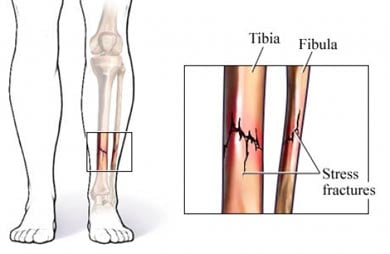
There are many similarities between soldiers and athletes, especially in training, which often exposes them to “fatigue fractures”, otherwise known as stress fractures. These injuries account for up to 20% of all sports medicine injuries, and over 50% occur below the knee! This injury is a partial or complete fracture after repetitive loading, so it is categorized as an overuse injury. Just think about stress fractures like the next step after shin splints or foot pain. Basically, the bone is unable to repair itself before the next physical stimulus; whether it is running with a drill sergeant or playing a tournament. Neither of these environments can really be changed, so we must seek to understand why it happens and then some quick, practical ways to avoid the stress…fracture that is.
An athlete with a high loading LOAD
A 2011 review out of the Delft University of Technology in the Netherlands examined all the literature on stress fractures, specifically the relationship between this injury and ground reaction force (GRF). The major finding was that the loading rate was significantly higher in the stress fracture group. The loading rate refers to the LOAD at which GRF is created. Subjects who produced force quicker upon impact were more likely to have stress fractures. Likewise, we have seen our athletes that create more LOAD are also more likely to develop pain in their lower legs (feet and shins). These findings are pretty intuitive, if you have higher LOAD, or are stiff like a wooden dowel, you are more likely to break than a flexible object like a rope.
The best way to prevent fatigue fractures is to limit the volume of exercise. However, the tricky part is knowing how much exercise is too much; how many games or how much distance crosses the threshold from a good stimulus to improve into injury risk. We use force plate analysis to identify at risk athletes, those with naturally high LOAD. Without this objective tool to, there are some practical, immediate solutions that both prevent and help rehabilitate stress fractures.
Fascia is cobwebs that vibrate to protect the muscles
1. Target the fascia by rolling out below knee, particularly the peroneals
At impact with the ground, vibrations are produced in the soft tissue, mostly bone and fascia. Better fascia means less bone stress.
2. Increase ankle muscles’ (your calves) flexibility so you can absorb impact and disperse the GRF
Muscles help the fascia mentioned above in a process called tuning; changing their activity to minimize the soft tissue vibrations that lead to injury. While this protective mechanism is initially sufficient, these vibrations must increase with fatigue in attempt to maintain the same levels of peak GRF.
3. Substitute running with non-impact, yet explosive activities
These movements simulate the same angles, such as slideboard. The other option is to ignore, or even ice the pain, you’ll recognize the smarter athletes when they slide by.
Zadpoor, A. A., Nikooyan, A. A. The relationship between stress fractures and the ground reaction force: a systematic review. Clinical Biomechanics. 2011. 26, 23-28.